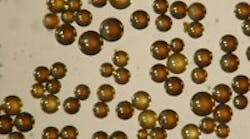IRON CATALYST
Figure 1. PS/PEG-supported iron nanoparticles have a mean diameter of 90 microns. Source: RIKEN.
The team from
McGill University, Montreal, the
RIKEN Center for Sustainable Resource Science, Wako, Japan, and the
Institute for Molecular Science, Okazaki, Japan, directly produce iron nanoparticles within a matrix composed of amphiphilic polymers based on polystyrene (PS) and polyethylene glycol (PEG) (Figure 1). The matrix protects the iron from rusting but allows reactants to reach the catalyst.In trials in a flow reactor, the catalysts showed excellent reactivity for selectively hydrogenating alkenes, alkynes, aromatic imines and aldehydes, nearly quantitatively in most cases, report the researchers. More details appear in a recent article in
Green Chemistry. "Our research is now focused on achieving a better understanding of how the polymers are protecting the surface of the iron from water, while at the same time allowing the iron to interact with the substrate," notes Audrey Moores, an assistant professor of chemistry at McGill. That work could take six months or more, adds fellow McGill researcher Reuben Hudson."We showed an unprecedented stability towards oxidation by water. However, we are not equipped to determine whether this will suffice in an industrial setting. We would actually need to partner with a company to make such an assessment. So, stability improvement may be the next challenge. This explains why we want to gain more insight into the mechanism of water resistance" Moore declares. The iron catalyst may be less susceptible to poisoning than noble-metal-based ones because its metal surface is less exposed, she notes."The next challenge is to optimize our catalyst to get the best activity. Right now the requirements in terms of temperature and pressure could be improved to better match current technology. [And] last, finding a synthesis for this catalyst that is easy to scale-up and industrialize will be crucial to sell the technology.""Our aim is to develop iron-based catalysts not only for hydrogenations but also [for] a variety of organic transformations that can be used in future industrial applications," adds RIKEN researcher Yoichi M. A. Yamada.
